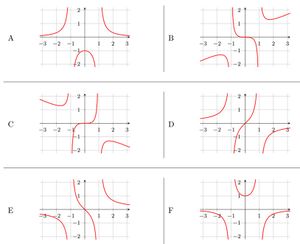Science:Math Exam Resources/Courses/MATH100/December 2016/Question 08
{{#incat:MER QGQ flag|{{#incat:MER QGH flag|{{#incat:MER QGS flag|}}}}}}
• Q1 (a) • Q1 (b) • Q1 (c) • Q2 (a) • Q2 (b) • Q2 (c) • Q2 (d) • Q3 (a) • Q3 (b) • Q3 (c) • Q4 (a) • Q4 (b) • Q4 (c) • Q5 (a) • Q5 (b) • Q5 (c) • Q6 (a) • Q6 (b) • Q7 (a) • Q7 (b) • Q8 • Q9 (a) (i) • Q9 (a) (ii) • Q9 (a) (iii) • Q9 (b) (i) • Q9 (b) (ii) • Q9 (b) (iii) • Q9 (c) (i) • Q9 (c) (ii) • Q9 (c) (iii) • Q10 (a) • Q10 (b) • Q11 (a) • Q11 (b) • Q12 • Q13 (a) • Q13 (b) • Q14 (a) • Q14 (b) •
Question 08 |
|---|
|
Consider the following six graphs on the right hand side.  Match the following five functions with the graphs: (i) (ii) (iii) (iv) (v) |
|
Make sure you understand the problem fully: What is the question asking you to do? Are there specific conditions or constraints that you should take note of? How will you know if your answer is correct from your work only? Can you rephrase the question in your own words in a way that makes sense to you? |
|
If you are stuck, check the hint below. Consider it for a while. Does it give you a new idea on how to approach the problem? If so, try it! |
Hint |
|---|
|
Identify the type of asymptotes of the given functions. Two of them have slant asymptotes while three of them have horizontal asymptotes. After you match the functions with slant asymptotes, for the rest of them find their derivatives to see whether there are any extrema and check for the sign of the derivative to help you determine if the functions are increasing/decreasing. |
|
Checking a solution serves two purposes: helping you if, after having used the hint, you still are stuck on the problem; or if you have solved the problem and would like to check your work.
|
Solution |
|---|
|
All the five given functions have two vertical asymptotes at and . Functions (i), (ii) and (iv) have a horizontal asymptote at . However, functions (iii) and (v) have a slant asymptote which is actually because the degree of the numerator (3) is the degree denominator (2) +1. This means that the graphs for these two functions are (B) and (C). To determine which one is for which function one way is to use long division of by and by to find the equation of the slant asymptote. Without doing any computation, we can see that since in the leading term has negative coefficient the long division will give a line with negative slope which means that (iii) C (v) B
(i) is a local minimum because for the derivative is negative (decreasing graph) and for the derivative is positive (increasing graph). F Similarly for (iv) is a local maximum because for the derivative is positive (increasing graph) and for the derivative is negative (decreasing graph). A For (ii) E. |
{{#incat:MER CT flag||
}}



















